As an Amazon Associate I earn from qualifying purchases.
It seems that in most food writing, every dish is breathlessly described as “life changing” or “earth shattering” or somesuch. Please, people. How life changing can a cronut actually be? And if it does fundamentally change your existence, you may want to stop for a moment and reassess your life. You’re doing something wrong.
That said, this Mexican stew is indeed a singular eating experience — at least in my own experience. Why? Char.
Char. Blackening. Burnt-ness. Fire. It is to real Mexican cooking what velveting is to Chinese cooking: A technique that most Americans who are not of that ethnic group aren’t fully aware of, a technique that sets the cuisine apart from the European traditions. Most of us experience the magic of char in Mexican cooking in salsas, when you see the little flecks of black among the chiles. But it’s everywhere across the cuisine, and when you as a home cook discover this you go a long way toward hitting the right notes when you make a Mexican dish at home.
This dish, a Yucatecan stew called chocolomo (cho-ko-LO-mo), hits that note hard.
I’d never heard of the recipe until I read the David Sterling’s excellent cookbook Yucatán: Recipes from a Culinary Expedition. It is one of the best Mexican cookbooks I’ve ever read, and, as I mentioned when I riffed off his recipe for cochinita pibil, I’d be making several dishes from this book.
Chocolomo is normally a beef dish, made with meat and offal from a losing bull after the weekly bullfight.
Here I used venison and some wobbly bits: Shanks, a piece of shoulder, a kidney or two, a heart and a tongue. But you could easily shift this stew to cover dark meat birds like ducks and especially geese, using the giblets along with leg and wing meat.
I often use the word “deep” to describe flavor, but here I really, really mean it. There are layers of flavor in chocolomo that make you linger over each spoonful, wondering why the hell no Mexican restaurant you’ve ever been to actually makes this thrifty stew. (The reason is because most Mexican restaurants in the United States are not staffed by Yucatecans.) Punctuating it all is that char flavor.
What do I mean by it? Well, I can almost guarantee you know what I am talking about. Probably the most common way to find it is your typical backyard party, where someone has slightly burnt the chicken on the grill. Maybe it was you. But you like that taste, don’t you? Just so long as it isn’t overdone.
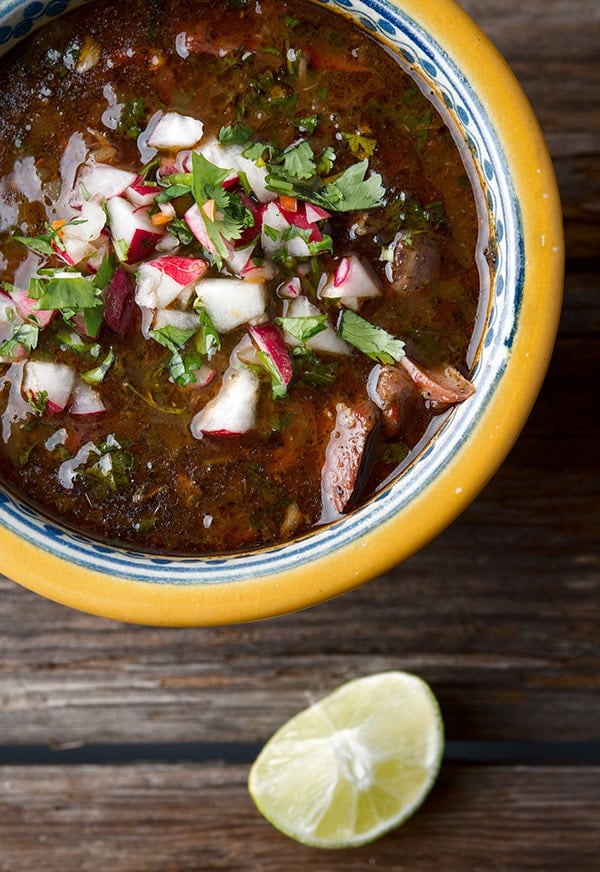
Argentine chef Francis Mallman puts the allure of the burnt this way in his book Seven Fires: Grilling the Argentine Way:
“I adore dissonance in food — two tastes fighting each other. It wakes up your palate and surprises you …charring or even burning adds an extra dimension to breads, vegetables and fruit. The right amount of burning or charring can be delicious and seductive: A burnt tomato, for example, has a has a dark crust bordering on bitter, while the inside is soft and gentle in texture and taste …what appeals to me is the element of danger and excitement in creating a burnt taste. Take the burning too far, and it destroys the dish. Stay just this side of the line, and it is lovely.”
Fire. Char. Burnt. Whatever you call it, there is an elemental, primal chord struck within us when we taste it. Desire for this flavor is most likely hard-wired in our primate brain, as it was fire that set us on our way to being who we are as a species. To capture it in a stew is truly something special.
Chocolomo, Mexican Venison Stew
Ingredients
STEW
- 1/4 cup lard or cooking oil, divided
- 3 pounds various meats and offal s(ee above)
- 2 quarts stock or broth
- 2 cups red wine
- 1/4 cup sherry or red wine vinegar
- Salt
- 1 large white onion, charred, peeled and chopped
- 1 head of garlic, charred, peeled and chopped
- 2 cups crushed tomatoes
- 1/2 cup chopped chives
- 1/2 cup chopped mint
TO FINISH
- Totopos (fried tortilla strips)
- Chopped radishes and cilantro
- Limes
- Hot sauce
SPICE PASTE
- 5 tablespoons black peppercorns
- 1 tablespoon cumin seeds
- 1 tablespoon dried oregano, Mexican if possible
- 2 teaspoons whole cloves
- 10 allspice berries
- 1/2 teaspoon ground cinnamon
- 2 heads of garlic, charred and peeled
- 2 tablespoons vinegar
Instructions
- Your first task is to make the spice paste, the recado bianco, which can be made days or even weeks ahead and then stored in the fridge. On a grill or gas burner, set the garlic heads over the fire. You want to burn off the paper and cook the garlic at the same time, so you will want to turn the heads frequently as they cook. You want some parts of the garlic to burn and char. This normally takes a solid 5 to 10 minutes, and longer is better. When they are cool enough to handle, peel off any remaining paper around the garlic cloves and chop them roughly. Set them in the bowl of a blender or small food processor with the vinegar.
- Toast the peppercorns, cumin, cloves and allspice in a dry pan over high heat until they are fragrant, a minute or three. Put them into a spice grinder with the oregano and cinnamon. Grind into a powder and add to the blender with the garlic. Buzz this to a paste, stopping to scrape down the sides of the blender or processor a few times. This paste will keep for months in the fridge.
- To make the stew, cut the meats and offal into pieces you'd want to eat. Get 3 tablespoons of the lard hot in a large, heavy, lidded pot like a Dutch oven. Pat the meats dry and brown them in batches so you don't crowd the pot. This may take a solid 20 minutes. As they brown, set the chunks in a bowl. When the meats are all browned, add some stock to the pot and use a wooden spoon to scrape up any browned bits on the bottom. Add the rest of the stock, the wine, vinegar, 4 tablespoons of your recado bianco spice mixture and the meats -- along with any juices that have collected in the bowl. Bring this to a simmer and add salt to taste. Cook until the meats are tender, which can be anything from 90 minutes to 4 hours.
- About an hour after the meats have started simmering, heat the last tablespoon of lard in a frying pan and cook the onion and garlic over medium heat until they're nice and softened, but not browned. Add the tomatoes and cook until most of the liquid has evaporated, then add the contents of the frying pan to the stew pot.
- When the meats are nice and tender, add the chives and mint and cook another couple minutes, just to wilt the herbs. Serve in big bowls with the finishing garnishes.
Notes
Nutrition
Nutrition information is automatically calculated, so should only be used as an approximation.
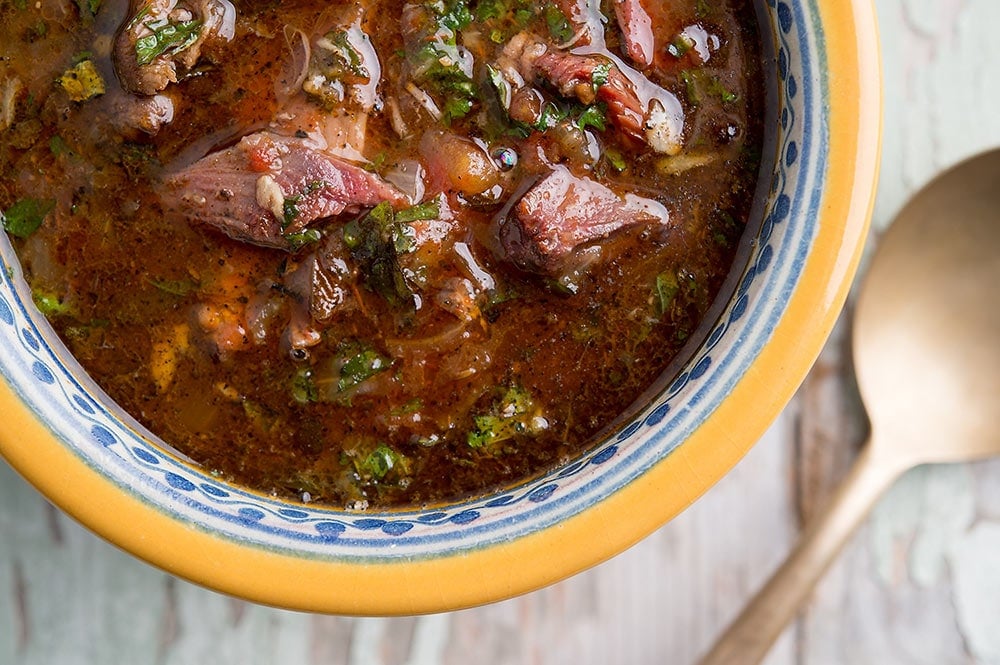

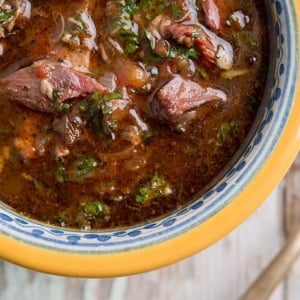
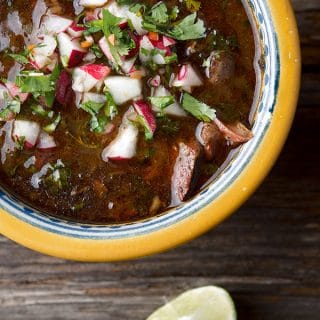


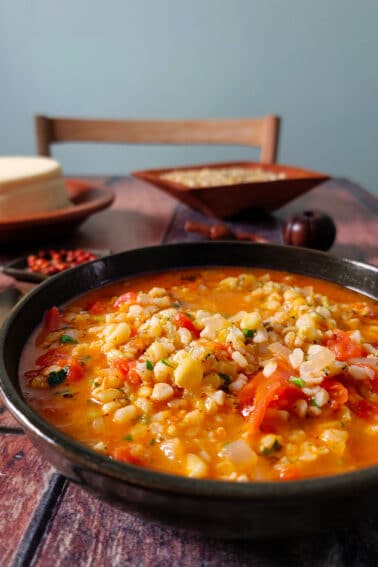
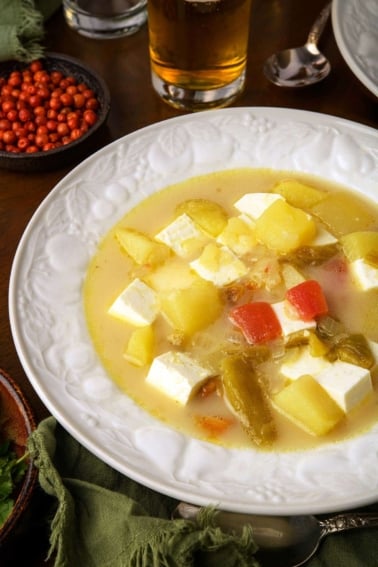
Hi Hank,
I’ve noticed that the Qty of recado bianco does not change when you adjust the number of servings (because it is in the text of the recipe). Can you clarify how many tablespoons should be used for a serving size of 4, or 8?
Dan: Yes, it will. It is the “spice paste” in the recipe. The amount it makes is enough for 16 people, or two batches of the stew.
Hi,
This sounds like a great recipe… Will it be a good idea to make this with ground venison meat?
Thanks
Viswa
Viswa: I wouldn’t. I prefer to make this with stew meat.
Hank,
Are you braising the tongue beforehand at all, or doing something so the skin peels off easily before cooking?
Steve: You either just let it simmer in the stew long enough to peel, about 2 hours or so, or pre-braise it and peel. I generally let it cook in the stew and fish it out to peel.
Amazing one of the best stews I’ve ever had
This is one of my favorite recipes of Hank’s (and it’s equally loved by family and friends), and I’ve made quite a few of them. It has a terrific and unique depth of flavor that just goes on and on- there’s nothing else really like it. It’s a bit of a labor of love to make, so if you’re pressed for time I’ve found it helpful to make the spice paste a day or two ahead of time before I do the stew. There’s usually leftover paste for next time, or to get creative with by adding some to other soups, stews, or chilis. And if you’re short on venison and wobbly bits, it’s still excellent with a 3 lb chuck roast from the store.
Give it a try, it’s well worth the effort and an excellent change of pace from chili or other stews.
Worth the effort! An incredible combination of complex flavors. Added chopped Avocado, Radish, Cilantro, and some Mexican hot sauce.
Is 2 tsp cloves correct? Seems like way too much.
William: It’s correct. Remember it is whole cloves. You want about 8 to 12 cloves.
We made this and it was amazing. But we still have leftover paste. Anyone have any good ideas for using the paste elsewhere?
Jordan: It will store in the fridge a while and the freezer forever, for when you make your next batch!
I had been intrigued by this recipe since it was posted. Yesterday, I finally made it with some of 2016’s elk (cuts of which had somehow gotten buried under 2017’s elk). I also tossed in a cubed and de-fatted beef heart (grass fed). This recipe was a fantastic treatment, and several hours in the crockpot on low allowed all of the flavors to coalesce into that interesting juxtaposition touted in the description. Thanks to Hank for elevating the art of cooking game, and for providing this type of recipe to expand my own horizons.
One note – I used beef stock. In the future, per the notes of another poster, I would likely opt for chicken or even vegetable stock. The meats I used needed no reinforcement, and a lighter stock might make for a better palette for the other flavors.
sadly it looks like our Christmas bison Hunt is not going to happen the animals just aren’t in the park so we switched over to jack rabbit hunting I was kind of sad at first until I saw this recipe happy girl
My wife and I have made this twice now with pork and holy crap is it good. Probably one of the best tasting meals that we have cooked at home due to the depth of flavor. Its also fun to cook with putting the vegetables straight on the coals and searing meat on high heat. First time we used chicken stock and cubed the meat before stewing it. Second time was pork stock and we shredded the meat after stewing. We also added corn towards the end of cooking, and pork belly chunks. It came out amazing the second time (first attempt was still super good). We pressure canned a couple of quarts for later.
Any particular kind of vinegar? Or just any type?
Lauri: Any kind of vinegar will do, but I prefer cider vinegar.
This sounds really good! i love the charred flavour and often dark fry many things to get it. I will have to try this! Thanks for the recipe! We prefer to eat wild meat, as opposed to the commercially farmes stuff.
Made this for the Super Bowl… and it came out super, a nice change from the standard “deer stew” or “chili” favor profile. Everything came out of the freezer or pantry except the fresh herbs and a loaf of French bread. I used a deer shoulder, a couple of shanks, a deer heart, and a couple of smoked turkey necks from the freezer. Some duck stock and duck fat to fry the charred onions and garlic. The spice mix and charred vegies really makes this stew a bit different, and it does get better with a day or two in the frig. This got top compliments from the boys at the pub and the hunt club, Thanks Hank.
Hi Hank
I find myself back at your site and love to explore your recipes. I have loved to cook since a child and I write a lot of cooking articles for publication as well as my own site. I love to read your recipes because I can actually taste the ingredients as I read and I can even taste a couple of my own ingredients as I ponder what I might add to the recipe to make it my own. This is why we love to cook and much like people who wonder how I can sit in a tree all day with a bow waiting for a deer there are people who wonder why I “love” to cook and just like my fruitless attempts at explaining why I bowhunt it is very difficult to explain all the great reasons I love to cook. I am always hopeful that through sharing our love of hunting and more importantly our love of cooking we can bridge that gap between the two and bring some people around to the real reasons we pursue fish and game and grow our own vegetables. I do love to hunt mature whitetails with my bow as it challenges me and forces me to improve every year and that’s great but in the end enjoying the harvest by preparing it yourself and learning about the recipe and its origins and trying new dishes and experiencing new flavors is what it is all about for many outdoors people and you do a great job sharing this with many people and only good can come of that.
Thanks for a great site
Ken McBroom
VP Hoosier Outdoor Writers
I’m very attracted to this recipe and dying to try it, but I’m confused … your post talks all about charring the onion and garlic, but the instructions in the recipe don’t char them at all. In fact, they say “cook the onion and garlic over medium heat until they’re nice and softened, but not browned” … how is that going to add “char”? Are the instructions correct?
Ann: Yes, they are correct. If you read the ingredient list, you will see the onions and garlic are to be charred, peeled and then chopped. Charring the outside does not cook the onions ad garlic through. Hope that clarifies things!
Oh my Hank!
A keeper for sure. We did it with venison and for the wobbly bits used chicken gizzards and hearts. As you said this dish did make the wife and I reassess our culinary outlook. Love the Buck, buck, moose shirt and am so looking forward to our book!
Marty and Pat Horn
Hi hank! Making this now! Smells amazing. I’m wondering if it would be a good idea to add some more vegetables such as potatoes, Celery, carrots. What do you think? Would that ruin the dish/authenticity?
Chris: You can do as you wish. This isn’t one of those tyrannical dishes like beans in chili or tomato in gumbo. 😉
You sold me on Yucatan, I got to buy the book now!